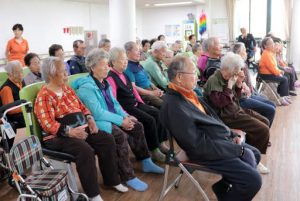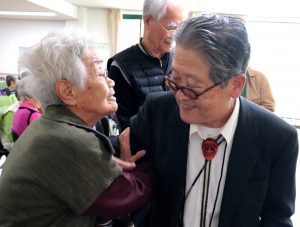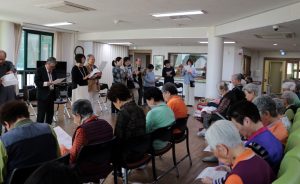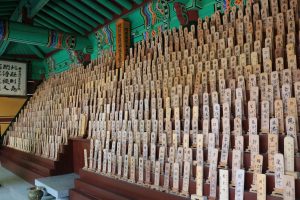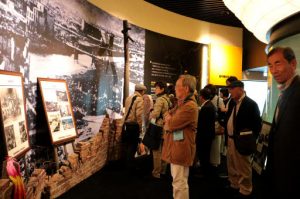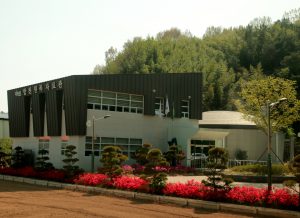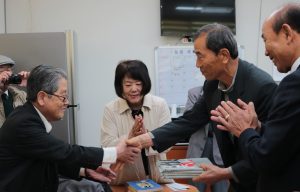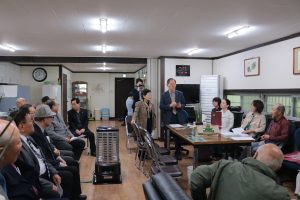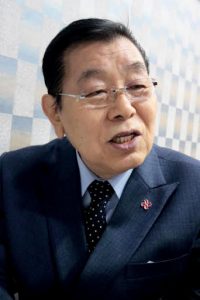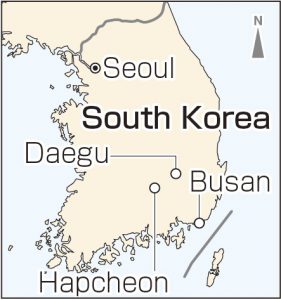A-bomb survivors from Hiroshima and Daegu, South Korea establish new exchange group to hand down A-bomb experiences
Apr. 29, 2019
by Miho Kuwajima, Staff Writer
About 2,240 South Korean A-bomb survivors who experienced the atomic bombing in Hiroshima or Nagasaki now live in their home country. With support from citizens of the A-bombed cities and Japanese A-bomb survivors, the Korean survivors persisted in their efforts to have the Japanese government fully apply the A-bomb survivor relief measures to the survivors living outside of Japan, too. Thanks to their efforts, the disparity in the relief received by the survivors, depending on their country of residence, has recently been resolved.
At this point, the Japanese and Korean people who had been engaged in these efforts are entering a new stage of promoting exchanges in addition to the work they have pursued to gain greater support for survivors overseas. In other words, it is an initiative designed to spread the spirit which underlies their activities — that “A-bomb survivors are all equal regardless of where they now live” — to the next generation, while handing down to them the A-bomb experience. In April, the Chugoku Shimbun visited South Korea with members of a citizens’ group from Hiroshima to look at their activities and the challenges that lie ahead for them.
Tears of emotion at exchange event
In an idyllic rural setting in Hapcheon County, in the southeastern part of South Korea, is the A-bomb Sufferers Welfare Center, a nursing facility which is home to about 100 South Korean A-bomb survivors. On April 20, members of a citizens’ group in Hiroshima called the “Hiroshima Branch of the Association of Citizens for Supporting South Korean Atomic Bomb Victims” (chaired by Etsuko Nakatani) paid a visit to this nursing home.
The average age of the residents at the A-bomb Sufferers Welfare Center is 84. They experienced the atomic bombing in Hiroshima and returned to South Korea after the war ended. Lee Suyong, 90, was moved to tears of emotion as she sat in the front row at the exchange event. When the atomic bomb exploded above the city of Hiroshima, Ms. Lee was at the Hiroshima Postal Savings building, located 1.5 kilometers from the hypocenter. Though she was covered in blood from her wounds, she was able to survive the ordeal. In November 1945, she returned to her homeland with her family via a boat that smuggled migrants.
Ms. Lee said, “I grew up in Japan so at first I couldn’t understand the Korean language. My life was really hard after returning to South Korea.” She then raised four children, and now has eight grandchildren. However, she has never told her grandchildren about her A-bomb experience. She said, “The reason is, if people know that I experienced the atomic bombing, it would negatively affect my grandchildren’s prospects for marriage.”
Support for the A-bombings still dominates in South Korea
In South Korea, many people still hold the view that the atomic bombings helped lead to Japan’s defeat in World War II and Korea’s liberation from Japan, which had colonized the Korean Peninsula during the war. As a result, there are few opportunities for Korean A-bomb survivors to share their experiences. Lee Gu Yeol, 73, the chair of the South Korean Atomic Bomb Sufferers Association, said, “They keep silent because of the discrimination that exists against A-bomb survivors. That’s why their A-bomb experiences aren’t widely known to the people of South Korea.” Mr. Lee was in his mother’s womb when they were exposed to the Hiroshima bombing.
“We’re getting old now,” said Keisaburo Toyonaga, 83, a member of the group from Hiroshima who lives in Aki Ward. “While we’re still alive, and have the chance, we want to reach out to young people in Japan and South Korea so we can hand down the experiences of the South Korean A-bomb survivors and the history of our support activities in Japan to the next generation.” Mr. Toyonaga has been a supporter since 1972, helping South Korean survivors obtain the Atomic Bomb Survivor’s Certificate and travel to Japan to receive medical treatment. The aim of his current visit to South Korea is to join forces with the Daegyeong Branch of the South Korean Atomic Bomb Sufferers Association in Daegu and form a peace exchange group called the “Group of Citizens in Daegu and Hiroshima to Realize the Abolition of Nuclear Weapons and a Peaceful World,” which will serve as a center for promoting exchange activities.
Members of the group from Hiroshima expect the new group to provide opportunities for young people of Japan and South Korea to listen to the A-bomb experiences related by Japanese and South Korean survivors and make efforts for the abolition of nuclear weapons, under the slogan that “the tragedy of the atomic bombings must never be repeated.” Ryu Byong Moon, 74, the chair of the Busan Branch of the South Korean A-bomb Sufferers Association, experienced the atomic bombing of Hiroshima when he just nine months old. Empathizing with the aims of his Japanese counterparts, he said, “People around my age are part of the last generation to experience the atomic bombing directly. Though I can’t speak Japanese, and don’t personally remember my experience of the atomic bombing, I want to advance these exchange activities with them.”
Differences in perceptions are seen, too
At the same time, there are some differences, or gaps, between the two sides relating to their perceptions of the “damages caused by the atomic bombing” and “sharing their experience to younger generations.”
One of the South Korean survivors said firmly, “At the time of the atomic bombing, we were under Japan’s colonial rule while the Japanese survivors were on the ruler’s side. So there’s a difference in our position as A-bomb survivors.”
In fact, rather than efforts for nuclear abolition, the members of the South Korean group seem to be more focused on activities to gain medical assistance for the second- and third-generation A-bomb survivors in South Korea. Their activities are bearing fruit as, for example, an ordinance was passed in Busan to support second- and third-generation A-bomb survivors there. The Atomic Bomb Museum, which opened in Hapcheon County two years ago, shares the sufferings of the South Korean A-bomb survivors with visitors, yet also contends that the children and grandchildren of these survivors have experienced health problems.
During the era of Japan’s colonial rule, the South Korean survivors were forced to endure poverty, war-time recruitment, and the military draft pursued by Japan. Then, after returning to South Korea, they became caught up in the Korean War. As a result, many of them suffered from the aftereffects of the bombing without receiving any assistance from the government. The members of the group from Hiroshima expressed their hope for new peace exchanges between Japan and South Korea, saying, “We would like the citizens of Hiroshima to take a stronger interest in handing down the experiences of the A-bomb survivors living abroad to younger generations by understanding that the damages caused by the atomic bombing also led to the history of suffering faced by the South Korean survivors.”
Interview with Han Pan-gae, chair of the Daegyeong Branch of the South Korean Atomic Bomb Sufferers Association
On the significance of exchanges with people in Hiroshima from the perspective of the South Korean A-bomb survivors group, Han Pan-gae, 82, the chair of the Daegyeong Branch of the South Korean Atomic Bomb Sufferers Association, shared his thoughts with the Chugoku Shimbun.
I think it’s important that the A-bomb survivors in Japan and South Korea promote exchanges with one another. Though current relations between Japan and South Korea aren’t so positive, the hardships we have experienced as A-bomb survivors are the same regardless of whether we are Japanese or South Korean. The political conditions between the two nations have no bearing on this. We would like to take action together so we can realize the goal of a peaceful world without nuclear weapons.
Most of the South Koreans who went to Japan and experienced the atomic bombing were from poor families. Even though they were free to return to their homeland after the war ended, they faced hard times because they had no foundation for creating a livelihood in South Korea. And in particular, for the South Korean A-bomb survivors, they faced dual discrimination. Many people had difficulty finding a marriage partner or they had to get divorced. This situation, which keeps them from recounting their A-bomb experience to others, still persists today.
I was eight year old when I experienced the atomic bombing in Uchikoshi-cho (now part of Nishi Ward) and fled to Oshiba Park. I saw many people there, their skin burnt and melted and dripping off their bodies. It was a horrific scene. The atomic bombing was truly terrible.
The Korean Peninsula remains divided, and there is also the issue of North Korea’s nuclear arsenal. But the terror of nuclear weapons that I experienced personally isn’t clearly grasped by the people here. We want to hold a photo exhibition to convey the actual damages wrought by the atomic bombing. Of course, we need to make regular visits back and forth. I’m looking into the possibility of visiting Hiroshima next year. As one of the South Korean A-bomb survivors, during that visit I want to talk about what I experienced at the time of the atomic bombing and afterward in the post-war period.
(Originally published on April 29, 2019)
About 2,240 South Korean A-bomb survivors who experienced the atomic bombing in Hiroshima or Nagasaki now live in their home country. With support from citizens of the A-bombed cities and Japanese A-bomb survivors, the Korean survivors persisted in their efforts to have the Japanese government fully apply the A-bomb survivor relief measures to the survivors living outside of Japan, too. Thanks to their efforts, the disparity in the relief received by the survivors, depending on their country of residence, has recently been resolved.
At this point, the Japanese and Korean people who had been engaged in these efforts are entering a new stage of promoting exchanges in addition to the work they have pursued to gain greater support for survivors overseas. In other words, it is an initiative designed to spread the spirit which underlies their activities — that “A-bomb survivors are all equal regardless of where they now live” — to the next generation, while handing down to them the A-bomb experience. In April, the Chugoku Shimbun visited South Korea with members of a citizens’ group from Hiroshima to look at their activities and the challenges that lie ahead for them.
Tears of emotion at exchange event
In an idyllic rural setting in Hapcheon County, in the southeastern part of South Korea, is the A-bomb Sufferers Welfare Center, a nursing facility which is home to about 100 South Korean A-bomb survivors. On April 20, members of a citizens’ group in Hiroshima called the “Hiroshima Branch of the Association of Citizens for Supporting South Korean Atomic Bomb Victims” (chaired by Etsuko Nakatani) paid a visit to this nursing home.
The average age of the residents at the A-bomb Sufferers Welfare Center is 84. They experienced the atomic bombing in Hiroshima and returned to South Korea after the war ended. Lee Suyong, 90, was moved to tears of emotion as she sat in the front row at the exchange event. When the atomic bomb exploded above the city of Hiroshima, Ms. Lee was at the Hiroshima Postal Savings building, located 1.5 kilometers from the hypocenter. Though she was covered in blood from her wounds, she was able to survive the ordeal. In November 1945, she returned to her homeland with her family via a boat that smuggled migrants.
Ms. Lee said, “I grew up in Japan so at first I couldn’t understand the Korean language. My life was really hard after returning to South Korea.” She then raised four children, and now has eight grandchildren. However, she has never told her grandchildren about her A-bomb experience. She said, “The reason is, if people know that I experienced the atomic bombing, it would negatively affect my grandchildren’s prospects for marriage.”
Support for the A-bombings still dominates in South Korea
In South Korea, many people still hold the view that the atomic bombings helped lead to Japan’s defeat in World War II and Korea’s liberation from Japan, which had colonized the Korean Peninsula during the war. As a result, there are few opportunities for Korean A-bomb survivors to share their experiences. Lee Gu Yeol, 73, the chair of the South Korean Atomic Bomb Sufferers Association, said, “They keep silent because of the discrimination that exists against A-bomb survivors. That’s why their A-bomb experiences aren’t widely known to the people of South Korea.” Mr. Lee was in his mother’s womb when they were exposed to the Hiroshima bombing.
“We’re getting old now,” said Keisaburo Toyonaga, 83, a member of the group from Hiroshima who lives in Aki Ward. “While we’re still alive, and have the chance, we want to reach out to young people in Japan and South Korea so we can hand down the experiences of the South Korean A-bomb survivors and the history of our support activities in Japan to the next generation.” Mr. Toyonaga has been a supporter since 1972, helping South Korean survivors obtain the Atomic Bomb Survivor’s Certificate and travel to Japan to receive medical treatment. The aim of his current visit to South Korea is to join forces with the Daegyeong Branch of the South Korean Atomic Bomb Sufferers Association in Daegu and form a peace exchange group called the “Group of Citizens in Daegu and Hiroshima to Realize the Abolition of Nuclear Weapons and a Peaceful World,” which will serve as a center for promoting exchange activities.
Members of the group from Hiroshima expect the new group to provide opportunities for young people of Japan and South Korea to listen to the A-bomb experiences related by Japanese and South Korean survivors and make efforts for the abolition of nuclear weapons, under the slogan that “the tragedy of the atomic bombings must never be repeated.” Ryu Byong Moon, 74, the chair of the Busan Branch of the South Korean A-bomb Sufferers Association, experienced the atomic bombing of Hiroshima when he just nine months old. Empathizing with the aims of his Japanese counterparts, he said, “People around my age are part of the last generation to experience the atomic bombing directly. Though I can’t speak Japanese, and don’t personally remember my experience of the atomic bombing, I want to advance these exchange activities with them.”
Differences in perceptions are seen, too
At the same time, there are some differences, or gaps, between the two sides relating to their perceptions of the “damages caused by the atomic bombing” and “sharing their experience to younger generations.”
One of the South Korean survivors said firmly, “At the time of the atomic bombing, we were under Japan’s colonial rule while the Japanese survivors were on the ruler’s side. So there’s a difference in our position as A-bomb survivors.”
In fact, rather than efforts for nuclear abolition, the members of the South Korean group seem to be more focused on activities to gain medical assistance for the second- and third-generation A-bomb survivors in South Korea. Their activities are bearing fruit as, for example, an ordinance was passed in Busan to support second- and third-generation A-bomb survivors there. The Atomic Bomb Museum, which opened in Hapcheon County two years ago, shares the sufferings of the South Korean A-bomb survivors with visitors, yet also contends that the children and grandchildren of these survivors have experienced health problems.
During the era of Japan’s colonial rule, the South Korean survivors were forced to endure poverty, war-time recruitment, and the military draft pursued by Japan. Then, after returning to South Korea, they became caught up in the Korean War. As a result, many of them suffered from the aftereffects of the bombing without receiving any assistance from the government. The members of the group from Hiroshima expressed their hope for new peace exchanges between Japan and South Korea, saying, “We would like the citizens of Hiroshima to take a stronger interest in handing down the experiences of the A-bomb survivors living abroad to younger generations by understanding that the damages caused by the atomic bombing also led to the history of suffering faced by the South Korean survivors.”
Interview with Han Pan-gae, chair of the Daegyeong Branch of the South Korean Atomic Bomb Sufferers Association
On the significance of exchanges with people in Hiroshima from the perspective of the South Korean A-bomb survivors group, Han Pan-gae, 82, the chair of the Daegyeong Branch of the South Korean Atomic Bomb Sufferers Association, shared his thoughts with the Chugoku Shimbun.
I think it’s important that the A-bomb survivors in Japan and South Korea promote exchanges with one another. Though current relations between Japan and South Korea aren’t so positive, the hardships we have experienced as A-bomb survivors are the same regardless of whether we are Japanese or South Korean. The political conditions between the two nations have no bearing on this. We would like to take action together so we can realize the goal of a peaceful world without nuclear weapons.
Most of the South Koreans who went to Japan and experienced the atomic bombing were from poor families. Even though they were free to return to their homeland after the war ended, they faced hard times because they had no foundation for creating a livelihood in South Korea. And in particular, for the South Korean A-bomb survivors, they faced dual discrimination. Many people had difficulty finding a marriage partner or they had to get divorced. This situation, which keeps them from recounting their A-bomb experience to others, still persists today.
I was eight year old when I experienced the atomic bombing in Uchikoshi-cho (now part of Nishi Ward) and fled to Oshiba Park. I saw many people there, their skin burnt and melted and dripping off their bodies. It was a horrific scene. The atomic bombing was truly terrible.
The Korean Peninsula remains divided, and there is also the issue of North Korea’s nuclear arsenal. But the terror of nuclear weapons that I experienced personally isn’t clearly grasped by the people here. We want to hold a photo exhibition to convey the actual damages wrought by the atomic bombing. Of course, we need to make regular visits back and forth. I’m looking into the possibility of visiting Hiroshima next year. As one of the South Korean A-bomb survivors, during that visit I want to talk about what I experienced at the time of the atomic bombing and afterward in the post-war period.
(Originally published on April 29, 2019)

